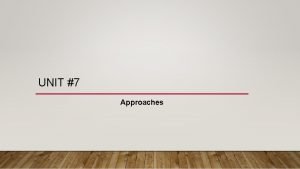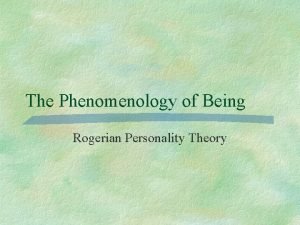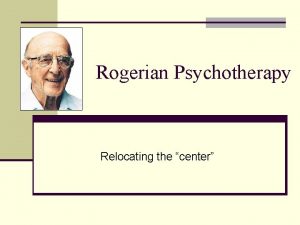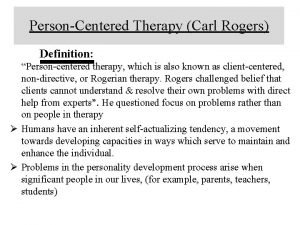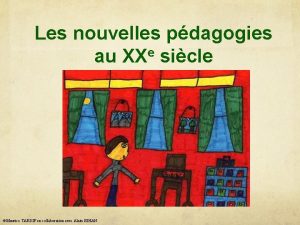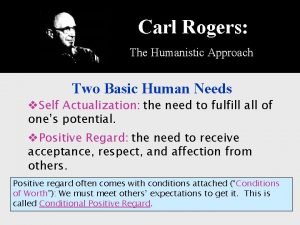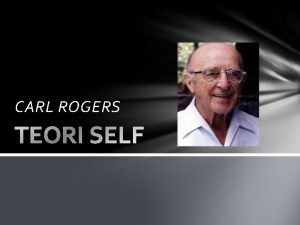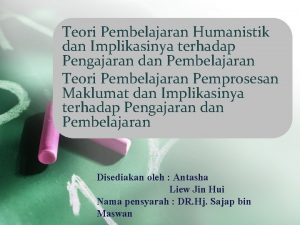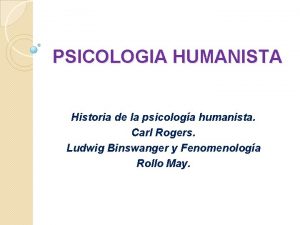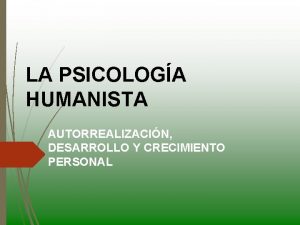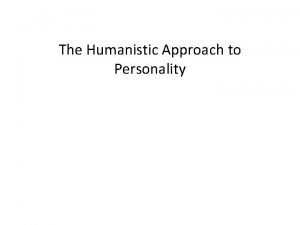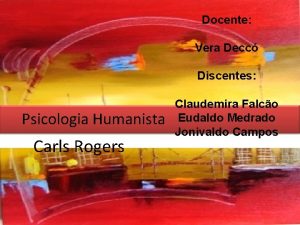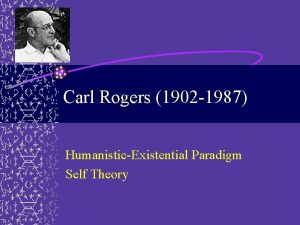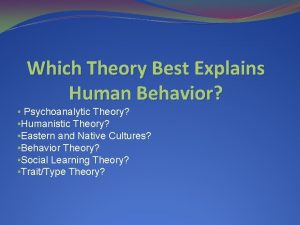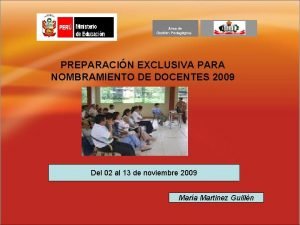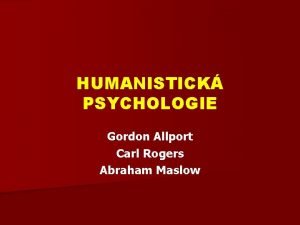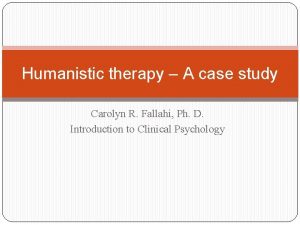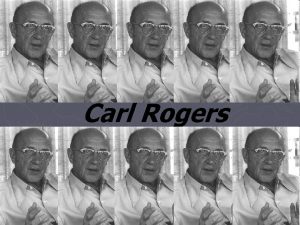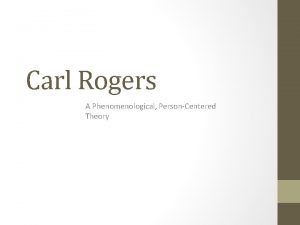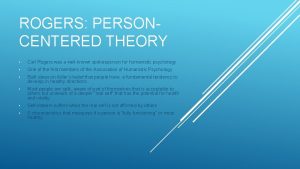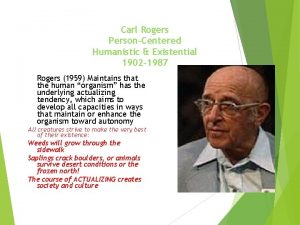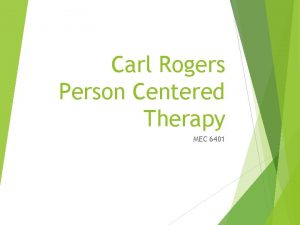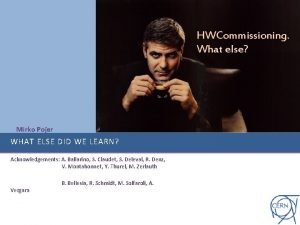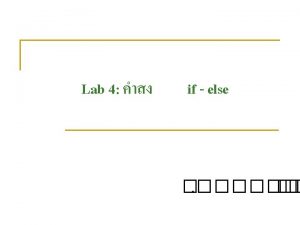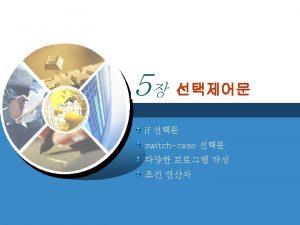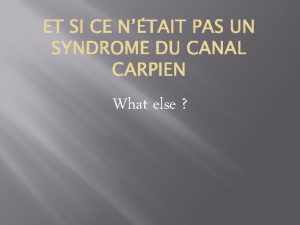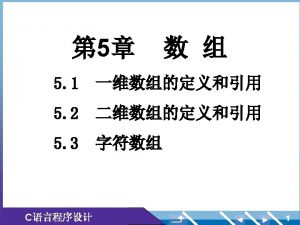Carl Rogers As no one else can know



























- Slides: 27

Carl Rogers “As no one else can know how we perceive, we are the best experts on ourselves” Ericka Skinner 3/26/2013

Bio Born January 8 th, 1902 in Oak Park Illinois Fourth of six children Father -civil engineer Mother-homemaker and devout Pentecostal Christian Could read before Kindergarten Spent his adolescence in a strict religious and ethical environment on a farm Isolated, independent, and disciplined person

Bio Continued American Humanistic Psychologist Focused on the concepts of the Self: v v Self Awareness Self Worth Ideal Self actualization

Education The University of Wisconsin Madison 1. Agriculture 2. History 3. Religion

Columbia University Teaching MA in 1928 and a Ph. D in 1931 Became interested in psychology after a child study Lectured and served as director of the Society for the Prevention of Cruelty to Children in Rochester, New York Became professor of clinical psychology at Ohio State University and began to focus on client centered therapy.

Humanistic Psychologists Emphasize the whole person and look at human behavior not only through the eyes of the observer, but through the eyes of the person doing the behaving People behave the way we do because of the way we perceive our situation Reject the deterministic nature of both psychoanalysis and behaviorism All people are good and capable of growth

Growth Achieved when: v People are in an environment that provides them with genuineness (openness and self-disclosure) v People are accepted by others (being seen with unconditional positive regard) v Capable of giving and receiving empathy (being listened to and understood) Ø Form Our Personalities

Client Centered Therapy Also known as: v Non-directive therapy and Rogerian Therapy Establishing a relationship with an understanding, accepting therapist, can resolve difficulties and gain the insight necessary to restructure the lives of the clients. Therapists guide clients even in subtle ways, while clients look for guidance from therapists

Client Centered Therapy http: //www. youtube. com/watch? v=Dj. Tp. EL 8 acfo

Client Individuals seeking therapy are to be referred to as clients, not patients Emphasizes the importance of the individual in seeking assistance, controlling their destiny and overcoming their difficulties Patient is makes it seem as if they client is sick and searching for a cure through therapist

Sigmund Freud Therapeutic relationship between therapist and client could lead to insights and lasting changes in the client. Freud offered unconscious explanations to his clients to explain their behavior Rogers wanted his clients to figure out their behavior themselves. v No solutions v No Judgment

3 Key Qualities of Client Centered Therapy Genuineness-therapist shares his or her feelings honestly with their client to encourage the client to share his or her feelings honestly as well. Unconditional positive regard- therapist accepts the client for who they are and display support and care no matter what the client is facing or experiencing. Empathetic understanding- allows the client to get a better understanding of their own inner thought, perceptions, and emotions through therapist

Self-Concept Organized/consistent set of perceptions and beliefs about oneself. Formed by v childhood experiences v evaluation by others. We want to feel/experience, thus behave in ways which are consistent with our self-image and which reflect what we would like to be like, our ideal-self

3 Components of Self. Concept Self worth (or self-esteem) – what we think about ourselves. Rogers believed feelings of self-worth developed in early childhood and were formed from the interaction of the child with the mother and father. Self-image – How we see ourselves, which is important to good psychological health. Self-image includes the influence of our body image on inner personality. At a simple level, we might perceive ourselves as a good or bad person, beautiful or ugly. Self-image has an affect on how a person thinks feels and behaves in the world. Ideal self – This is the person who we would like to be. It consists of our goals and ambitions in life, and is dynamic – i. e. forever changing. The ideal self in childhood is not the ideal self in our teens or late twenties etc.

Congruency and Incongruency Congruent- the closer our self-image and ideal-self are to each other, the more consistent or congruent we are and the higher our sense of self-worth Incongruence- if some of the totality of their experience is unacceptable to the individual and is denied or distorted in the self-image. (Everyone experiences it)

Congruence

Self Worth Develops during childhood from interactions with parents High self-worth- confidence and positive feelings about him or herself, faces challenges in life, accepts failure and unhappiness at times, and is open with people. Low self-worth- avoids challenges in life, not able to accept that life can be painful and unhappy at times, and will be become defensive and guarded with other people. (truth hurts)

Needs We need to feel valued, respected, treated with affection and loved. Positive regard- how other people evaluate and judge us in social interaction. Unconditional positive regard is where parents/ significant others/ therapist accepts and loves the person for what he or she is Conditional positive regard is where positive regard, praise and approval of child for behaving in ways that the parents think correct.

Self Actualization Major Goal! This is the belief that every person can achieve their goals, wishes and desires in life. Highest potential according to personality Ideal self is congruent with their actual behavior Fully Functioning!

Fully Functioning In touch with the here and now, his or her subjective experiences and feelings, and continually growing and changing Free of poor self-concept or external constraints

5 Characteristics of Fully Functioning Individuals First-openness to experience: both positive and negative emotions accepted. Second-existential living: Being able to live and fully appreciate the present, not always looking back to the past or forward to the future. Third-the trust feeling: feelings, instincts and gut-reactions are paid attention to and trusted Fourth- creativity: creative thinking and risk taking are features of a person’s life. This involves the ability to adjust and change and seek new experiences. Fifth- fulfilled life: when a person is happy and satisfied with life, and always looking for new challenges and experiences.

Later Life In 1945, Rogers was invited to set up a counseling center at the University of Chicago 1947 he was elected President of the American Psychological Association 1956 Rogers became the first President of the American Academy of Psychotherapists He taught psychology at the University of Wisconsin, Madison until 1963 and during he was elected a Fellow of the American Academy of Arts and Sciences New Center for Studies of the Person in La Jolla where he worked for doing therapy, giving speeches, and wrote the rest of his life

The Person-Centered Approach Workshops Devoted to applying his theories in situations of political oppression and national social conflict, traveling worldwide with his daughter and other fellow psychologists between 1974 and 1984 US, Europe, Brazil and Japan Focused on cross-cultural communications, personal growth, self-empowerment, and learning for social change Nominated for the Nobel Peace prize just days after his death.

Death Rogers suffered a fall that resulted in a fractured pelvis: he had life alert and was able to contact paramedics. He had a successful operation, but his pancreas failed the next night and he died a few days later on February 4 th, 1987.

Today Medical Professionals offer therapeutic environment that is conformable, non-judgmental, and empathetic. Via guidelines of Carl Rogers

References Brennan, J. (1998). Readings in The History and Systems of Psychology. (2 nd ed. ). Upper Saddle River: Prentice Hall Inc. Cherry, K. (2013). Client-Centered Therapy Carl Rogers' Non-directive Approach to Therapy. Retrieved from http: //psychology. about. com/od/typesofpsychotherapy/a/cl ient-centered-therapy. htm Hall, K. (1997, 05). Carl Rogers. Retrieved from http: //www. muskingum. edu/~psych/psycweb/history/roger s. htm Mc. Leod, S. (2012). Carl Rogers. Retrieved from http: //www. simplypsychology. org/carl-rogers. html

 Well myself and somebody else and somebody else analysis
Well myself and somebody else and somebody else analysis Carl rogers humanistic approach
Carl rogers humanistic approach Carl rogers phenomenological theory of personality
Carl rogers phenomenological theory of personality Carl rogers 19 propositions
Carl rogers 19 propositions Quién fue
Quién fue Carl rogers theory
Carl rogers theory Les 10 principes de carl rogers
Les 10 principes de carl rogers Definition of actual self
Definition of actual self Carl roger theory
Carl roger theory Biografi carl rogers
Biografi carl rogers Teori pembelajaran abraham maslow
Teori pembelajaran abraham maslow Teoria del crecimiento personal de carl rogers
Teoria del crecimiento personal de carl rogers Carls rogers teoria humanista
Carls rogers teoria humanista Maslows behovstrappa kritik
Maslows behovstrappa kritik El valor de ser persona
El valor de ser persona Humanistic personality test
Humanistic personality test Carls rogers biografia
Carls rogers biografia Carl rogers theory
Carl rogers theory Rogers self theory
Rogers self theory Carl rogers theory
Carl rogers theory Mapa conceptual de carl rogers
Mapa conceptual de carl rogers Agreeableness
Agreeableness Carl rogers potato analogy
Carl rogers potato analogy Carl rogers abraham maslow
Carl rogers abraham maslow Humanistic psychology case study
Humanistic psychology case study O que é psicologia humanista
O que é psicologia humanista Do you know who else is c=8
Do you know who else is c=8 Know history know self
Know history know self

